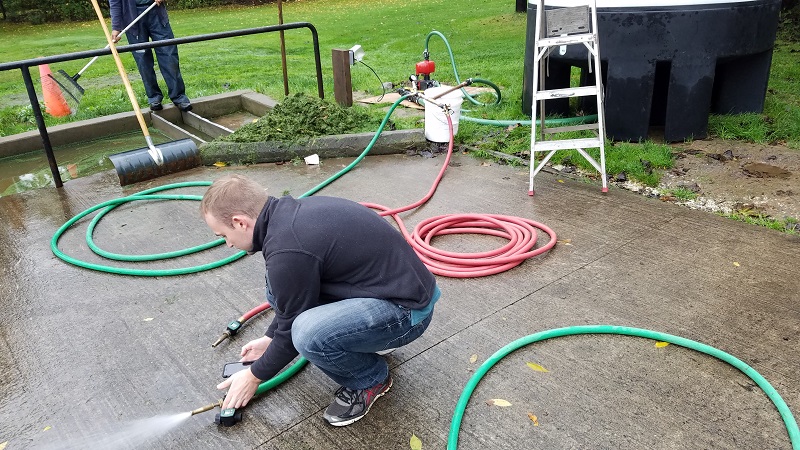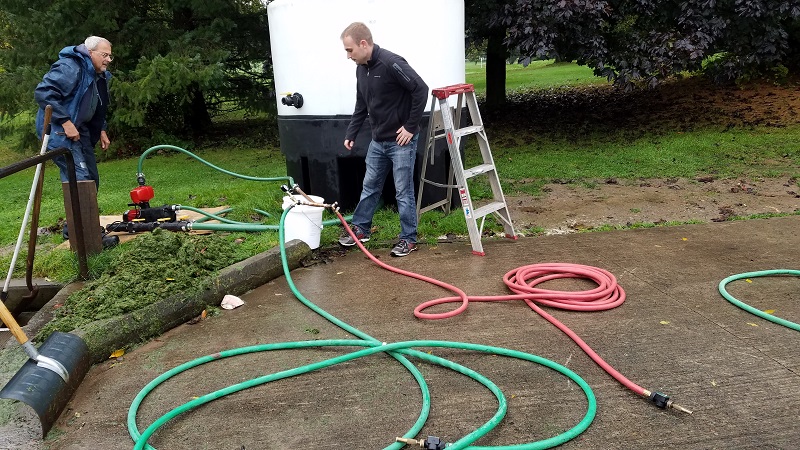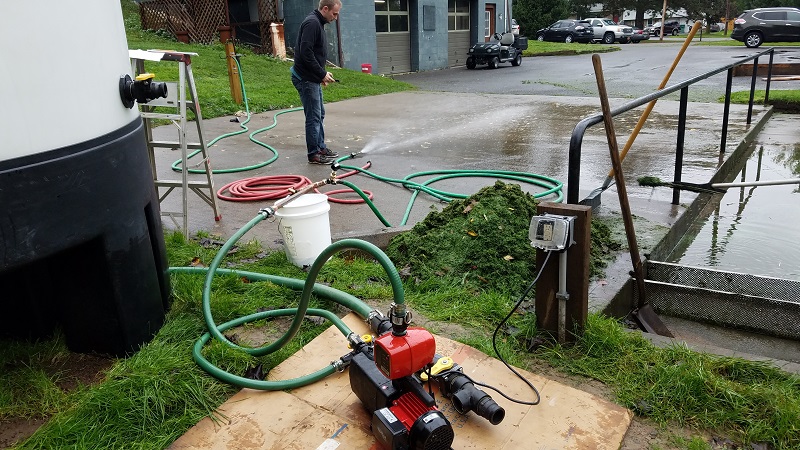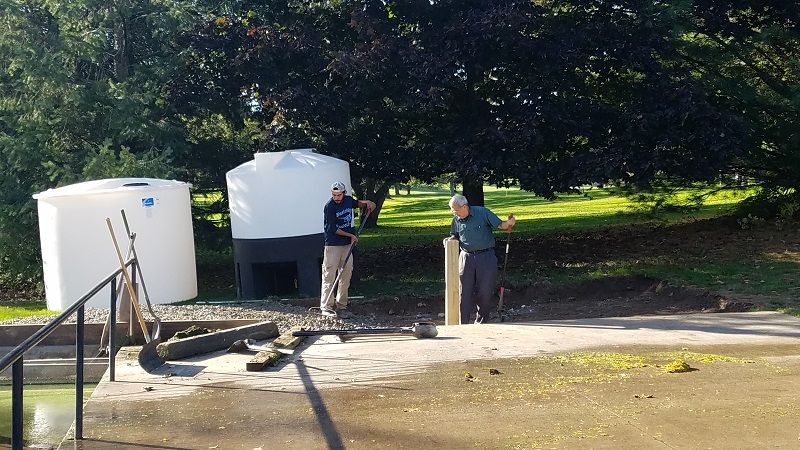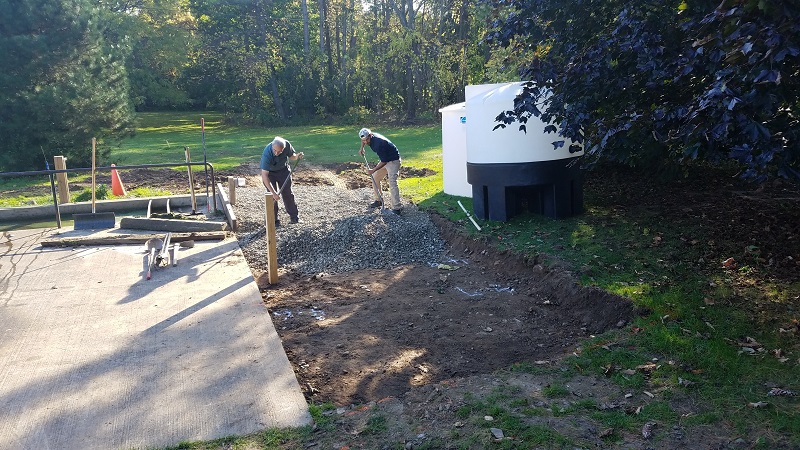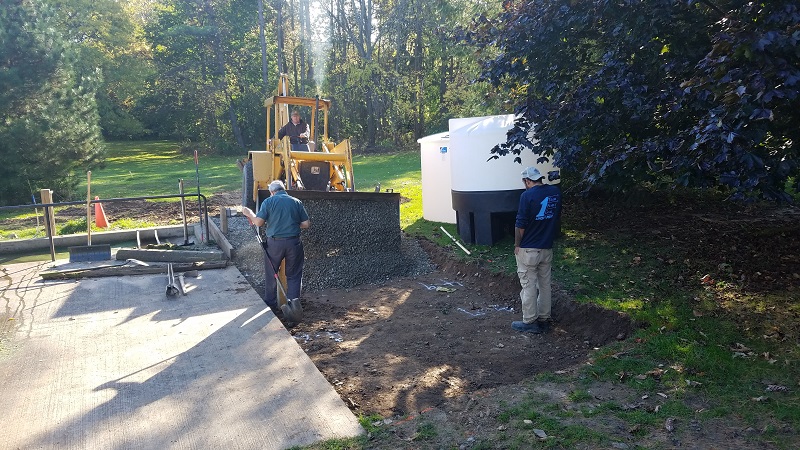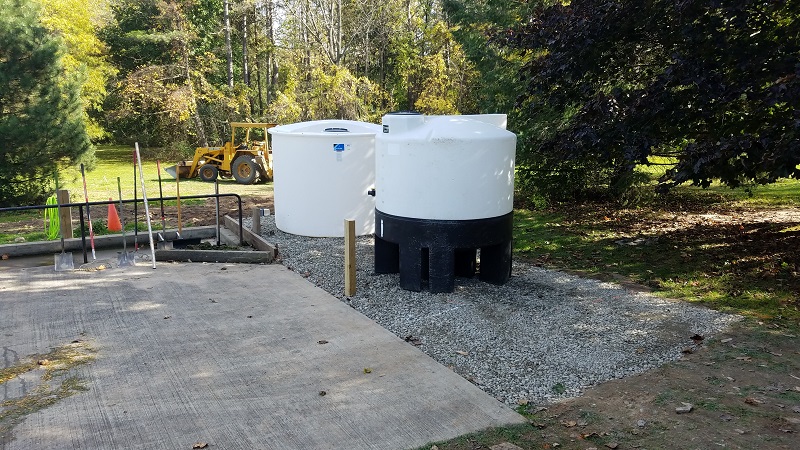Blog
Assess and Map Your Soils
Assessing soil health is a critical aspect of best management practices implementation, as underscored in the BMP statement:
Determine accurate supplemental nutrient needs based on soil chemical and physical analysis. On sand-based areas, consider foliar testing as a diagnostic tool.
The soil on your property has enormous environmental, and ultimately, economic value. You cannot implement a fully aligned BMP program until soils are properly assessed. Soil health, by definition, includes the physical, chemical and biological properties of the soil. Management efforts typically focus primarily on maximizing the parameters in each of these categories for agricultural crop production. However,targets for these soil health measurements are becoming clearer, which will assist superintendents in growing healthy, dense turf.
To begin a soil health assessment, start with the Web Soil Survey. UW-Madison Professor Doug Soldat published a great article in 2015 outlining the importance and practical use of the Web Soil Survey tool: https://websoilsurvey.sc.egov.usda.gov/App/HomePage.htm. Here’s my favorite quote from the article:
“The Web Soil Survey is a powerful tool that has many applications for site assessment and planning. The maps can be a powerful communication tool to explain to your golfers, parents, customers, board members, or supervisors about the challenges of growing turf on your site.”
Soil survey maps provide excellent information for your records to justify certain needs or assist in diagnosing problems. Of course, they can also be used to target soil samples from areas with known soil type differences to develop a more practical map that includes additional physical, and some chemical, properties. Knowing these properties is critical to assessing water quality risks from nutrient applications (e.g. potential for leaching), to determining the need for nutrient applications and to interpreting overall soil health.


Of course, more detailed chemical and physical analyses based on laboratory results are useful on large managed turf areas such as fairways and roughs, where large scale nutrient applications are made and greater risk to water quality (e.g. runoff or leaching) exists. Currently, the level of interpretation and practical value of chemical and biological tests is limited. However, it is important to know the physical properties, drainage class, and pH of soils on your entire property that are managed in some way, from native areas to putting surfaces. Therefore, consider the following incremental approach to BMP implementation when developing a nutrient management program:
A good practice is to assess the chemical and physical analysis of your regularly fertilized soils using a Minimum Level for Sustainable Nutrition (MLSN) Guideline interpretation, as well as looking at overall turf quality and growth, when developing a nutrient management program. Make accurate supplemental nutrient applications to targeted areas of established need.
A better practice is to use the Web Soil Survey as a guide to classify and sample all soils on the property using the MLSN interpretation and performance variables (quality and growth). Make supplemental applications of nutrients based on large-scale mapping in targeted areas of well-established needs.
The best practice would be to implement the above Web Soil Survey-driven sampling program and use appropriate interpretation and performance variables as layers in a GIS database built from the sampling locations. Use this GIS database of soil properties for GPS-based Variable Rate Application equipment for precise supplemental nutrient applications to targeted areas of well-established need.
New Case Study Video
Visit the NYS BMP Youtub channel to view the new case study video on the low cost washpad demonstration conducted at Locust Hill Country Club: https://tinyurl.com/y8m8o44t.
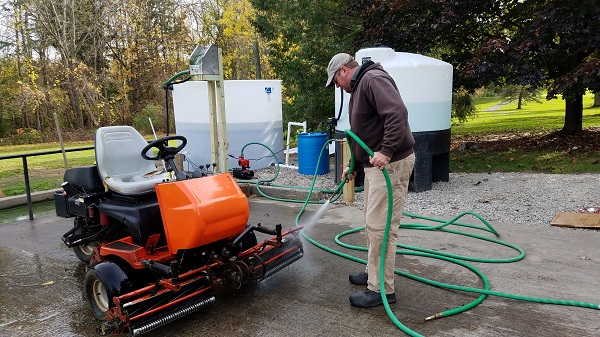
“Finding the Baseline”: A Simple Approach to Water Quality Monitoring
 As winter fades and the Spring rains arrive, a significant amount of water will flow along the surfaces of our golf courses and into wetlands, streams, rivers, lakes, and the spectacular estuaries of Long Island. In fact, New York State is associated with more than 15 individual watersheds (see inset to find your watershed).
As winter fades and the Spring rains arrive, a significant amount of water will flow along the surfaces of our golf courses and into wetlands, streams, rivers, lakes, and the spectacular estuaries of Long Island. In fact, New York State is associated with more than 15 individual watersheds (see inset to find your watershed).
In some parts of the world, regulatory agencies can impose strict water quality reporting requirements on land managers. In fact, strict water quality reporting has been considered within the Chesapeake Bay Watershed, the Susquehanna River Watershed, and is undoubtedly of interest to those involved in the various initiatives for nutrients and pesticides on Long Island.
As good land managers, it is vital that we understand any potential impact we could have on our local water bodies, and if possible, the groundwater below the land we manage. A good place to begin might be to test the water that passes through the golf course during the spring rainy period. In fact, one of the “Getting Started BMPs” states “Assess current surface and groundwater quality.”
Establishing baseline data is critical for representative water bodies and water sources that may be impacted by golf course operations. Baseline tests should be conducted 4x/year for the first year and should be taken from the same locations every time to ensure consistency.
The first step is to identify two sampling locations for testing flowing surface water ( creek/stream/river): one location where the water enters the property and the second where the water exits. The sample should not be collected directly from the side of the waterbody as sediment can contaminate the sample. If you must collect water near the edge of a water body, use a dipper or other type of extension to take the sample away from the shoreline. To collect the sample, use clean plastic containers that will hold at least a 100 ml and with lids that make a tight seal. Rinse the bottle (including the lid) several times with the water to be tested. Fill the sample bottle completely and eliminate all head space (no air space). Be sure the lid is tight so that samples do not leak during transit.
If possible, collect and ship samples to the laboratory on the same day. The same laboratory you already use for soil testing may offer water quality testing services as well. A basic analysis will include results for at least pH, nitrogen, phosphorus, and specific conductivity.
Two sample submissions collected four times in the first year might require about four total labor hours for collecting samples and sending out for analysis. Lab fees for basic analysis for the baseline data should be a couple of hundred dollars. More information on this BMP is available at https://nygcf.com/nysgolfbmp_com/water-quality-monitoring/.
Stuck in the Shop? Do a Point Source Pollution Assessment!
Winter in New York affords time for reflection on the growing season and planning for the new one. However, after a month of that exercise, you are still “stuck in the shop”! So while you are stuck inside why not conduct a review of the potential environmental risk? Did you know your maintenance shop is often the location on the course that poses the GREATEST risk to water quality – POINT source pollution.
A critical first step in aligning your facility with Best Management Practices is to assess potential point source pollution risk. Point source pollution is any single identifiable source of pollution from which pollutants are discharged, such as a pipe. Examples of point sources include:
- discharges from equipment washing area
- waste from pesticide
- fertilizer and equipment maintenance wastes
- unintended releases fertilizer and pesticides storage areas
It is clear much of this risk emanates from the maintenance shop area where equipment and chemicals are stored and transferred to and from equipment. Minimizing the risk from these areas begins with recognizing the potential for off-site movement, understanding any regulatory requirements associated with the volume of chemical storage or rinsate, and mitigating the risk through proper containment.
If you are considering a new facility, local building inspectors should be consulted during planning to outline the permitting process and local requirements. Also, consider meeting with a representative from a NYSDEC regional office and the local fire marshal. The NYSDEC requests a State Environmental Quality Review (SEQR) for new construction, which is administered by local governments. NYSDEC, and other interested and involved agencies, comments on SEQRs.
An excellent place to begin any assessment of your existing facility begins with understanding the regulatory guidelines that are provided by the NYSDEC. These have been summarized on the NYS BMP website.
A very practical article to consider the condition of your existing facility was penned in 2014 by USGA Senior Agronomist Dave Oatis, titled, I Know We Don’t Have the Money, but Can We Afford NOT to Invest in a New Maintenance Facility?
Since you are stuck inside, you might as well consider looking around at the building you might be stuck in and see if it measures up!
It’s not Sexy-The Long Play for the High Ground: Do the BMP Assessment and Survey Today!
Stewardship of the natural resources on New York State Golf Courses is the guiding principle behind the establishment and implementation of our Best Management Practices. The media, activists and a muted industry shape public perception, which in turn influences public policy. Try as we may, the golf industry is facing an uphill battle with the majority of the public regarding perception of our stewardship of the New York State’s natural resources. Further, an activist element exists in NY focused on health effects of pesticides and nutrients applied to the land, from farms and orchards to sports fields, lawns, and golf courses. Short term, developing relationships with members of our community off the golf course, educating members on the golf course, and communicating the “natural capital” of the course to policy and the regulatory community is critical.
The “long play” is to have data that tells the story. In an age when reputable sources of information are under siege by the “snap-face-chat-tweet” industry, collecting data that demonstrates action seems to be the best form of a quiet revolution. You can hide from contributing the data we need for BMPs to be tailored to our needs, you can avoid learning about aspects of your course may not entirely understand, but in the end, we each will be held accountable for how we steward the land under our care.
Not all of us can be a Ted Horton, Dan Dinelli, Anthony William or Matt Ceplo. But we can all be recognized for doing our part in shaping the future of environmental stewardship on golf courses in the 21st century. It takes very little time to answer the questions on the assessment of your knowledge, maybe a few more minutes to reflect on the survey of your current practices and their alignment with what science says right now is BEST-not good, not very good-but BEST.
Take 20-30 minutes and take the quiz and survey. It works on your phone, your desktop, laptop and tablet, it’s not sexy but it works. I doubt you will feel any excitement when you are done with the process, but knowing that you are making the long play for the high ground of environmental stewardship might provide a sense of greater accomplishment. It’s what’s BEST!
Results of the Low Cost Wash Pad Demonstration
Pollution Prevention Institute at RIT that partnered with Locust Hill CC on the low cost wash pad demonstration project has just published their case study on the project. Through a Turf Environmental Stewardship Fund grant, the BMP project was able to assist in the demonstration through sponsoring the cost of the equipment purchases (~$6,000) and the participation of Cornell University.
From RIT’s report on the case study, the results were as follows:
- After reductions of up to 50% using air blowing and different nozzles, approximately 700 gal/day of wastewater would need to be managed. Then if, this wastewater can be filtered and reused, overall reductions in wastewater would exceed 90%. A screen and sand filter was tested and installed, and a UV lamp was added to help control bacterial growth
- Equipment costs were approximately $6,000 and engineering support provided by NYSP2I
- As of Fall 2017, system working satisfactory and water recycled
- System will be monitored periodically for performance and quantification of water/wastewater reduction
Read the full project summary on the RIT website: https://tinyurl.com/y8oyb4bc

First test run of the completed system.
Calling all NYS Superintendents
Since publication of the New York State Best Management Practices for Golf in 2014, the BMP committee (now formalized as the New York Golf Course Foundation) has focused on outreach and education to promote the acceptance and implementation of BMPs. As part of these efforts, the state’s golf course professionals were surveyed two years ago to conduct both a formative assessment of BMP concepts and a survey of BMPs as implemented on NYS golf courses. Cornell University researchers analyzed the results and used the information to develop a plan to direct education and outreach efforts.
With funding provided by a Turf Environmental Stewardship Fund grant, the New York State Golf Foundation has updated the survey questions and is reintroducing the online BMP quiz and survey. This effort is designed to achieve several goals:
- To provide verifiable evidence for NYS regulatory agencies that a majority of New York State golf course superintendents are utilizing the BMP information.
- To assist superintendents in identifying areas for potential improvement in their golf course management operations.
- To encourage the use of the NYS BMP materials by identifying which topics are of greatest relevance.
- To raise awareness of the importance for superintendents to participate in the BMP project.
The foundation is asking for widespread participation in this effort. Therefore, golf turf professionals are asked to take the quiz and survey by March 30, 2018, on any internet-connected device. The quiz should be taken first, followed by the survey. Neither must be completed in one sitting, as all completed questions will be stored by IP address. Links to the quiz and survey are as follows:
Quiz: https://cornell.qualtrics.com/jfe/form/SV_74lNKzMfRichgDX
Survey: https://cornell.qualtrics.com/jfe/form/SV_0UIJ2xZYzptqZ4p
Wash Pad Demonstruction – Final Construction Activities
Construction on the wash pad prototype demonstration at Locust Hill Country Club is in the final construction stages (see the blog post describing the project and the blog post on mid-construction activities).
Below are photos showing the testing of the last component of the system, the booster pump, and construction of a level pad next to the existing wash pad for the equipment to be placed on. The booster pump will take water from the supply tank and pump it into the hoses used to clean equipment. As part of this process, the operating pressure and GPM were measured and determined to be within range engineered for the system.
Wash Pad Demonstration @ Locust Hill – Construction
Construction on the wash pad prototype demonstration at Locust Hill Country Club is currently underway (see our previous blog post description of the project). Below are photos from recent construction activities. Construction is expected to be completed by the end of next month.
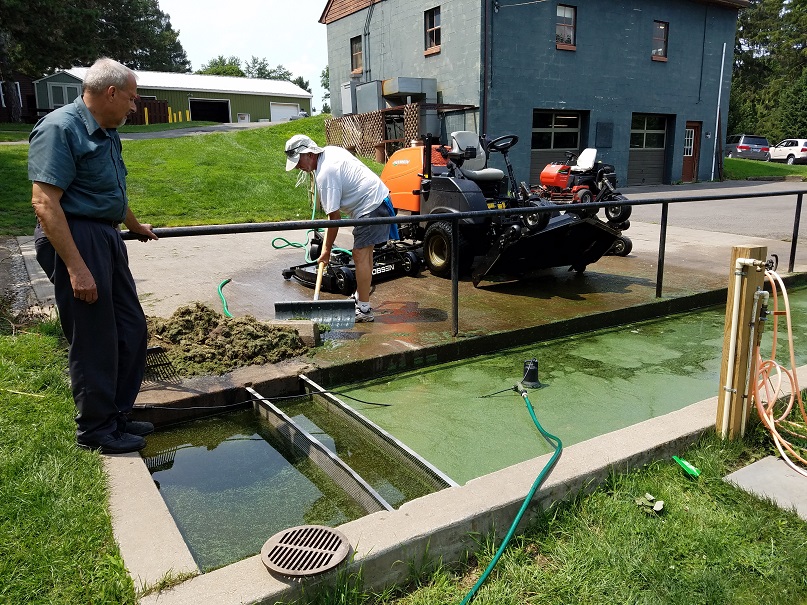
Testing a submersible pump. The pump will move water and debris from the trough into the hydroscreen.

Testing the hydroscreen The hydroscreen will remove larger debris.
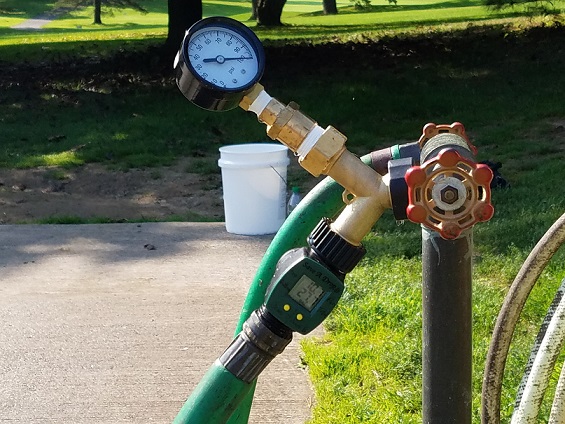
Installed pressure gauges and GPM gauges. These will monitor water flow during washing operations.
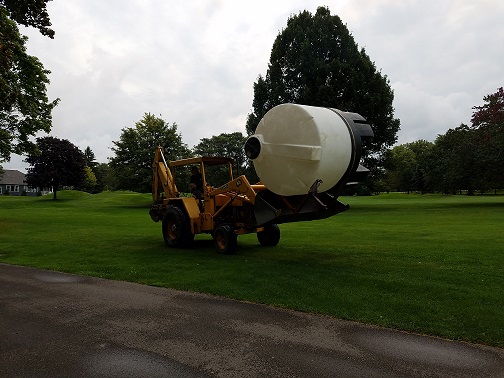
Moving the 1,000 gallon storage tank into place.
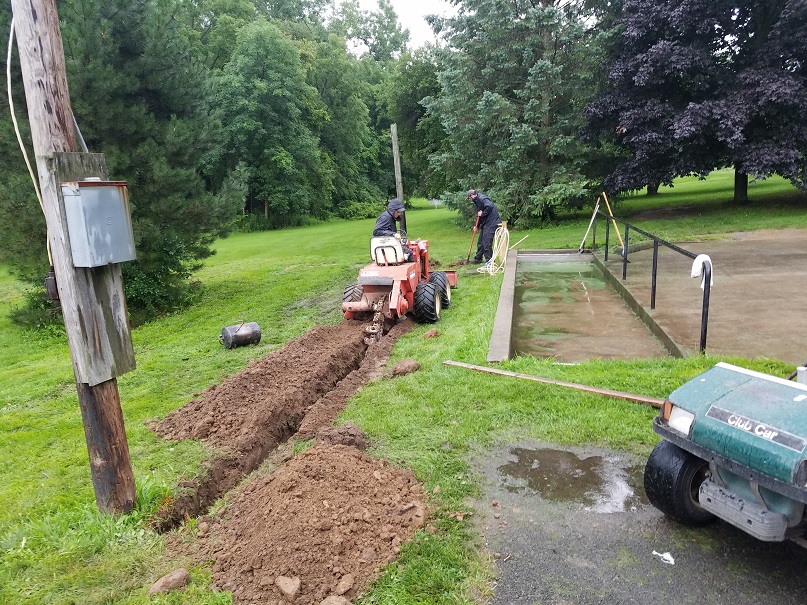
Trenching the ditch for the electrical line leading to the wash pad system location.
New Pollinator BMPs Published
 With funding from the Golf Course Superintendents Association of America (GCSAA) and the participation of Cornell University scientists and educators, the BMP project has developed BMPs specifically for pollinators in New York State. These continued efforts demonstrate the ongoing commitment of the state’s golf industry to implement BMPs and expand the knowledge base when needed.
With funding from the Golf Course Superintendents Association of America (GCSAA) and the participation of Cornell University scientists and educators, the BMP project has developed BMPs specifically for pollinators in New York State. These continued efforts demonstrate the ongoing commitment of the state’s golf industry to implement BMPs and expand the knowledge base when needed.
Both wild and managed bees are facing threats that can alter their health, abundance, and distribution. Research indicates that some pesticides can be harmful for pollinators and can have negative effects at the sub-individual level (such as gene expression or physiology), individual level (such as mortality, foraging, or learning), or even the colony level (such as colony growth, overwintering, or honey production).
Adhering to BMPs on the golf course can reduce the potential for impact to pollinators. A key practice is to utilize integrated pest management methods to reduce the number of pesticide applications, without sacrificing turf quality. When the use of pesticides is necessary, being mindful of pollinators requires focusing on minimizing exposure to non-target pollinators in play and non-play course areas.
Preserving and/or enhancing habitat, both foraging habitat and nesting sites, is another key strategy for golf courses to pursue to help pollinators. Pollinator-friendly habitat contains a diversity of blooming plants of different colors and heights, with blossoms throughout the entire growing season. Providing nesting sites for native species can be accomplished by taking simple steps in out-of-play areas, such as leaving stems and coarse, woody debris and leaving exposed patches of well-drained soil, or by creating nesting areas such as wooden nesting boxes for hole nesting bees or bamboo sticks.
In addition to providing habitat on the golf course, hosting honey bee hives on golf courses is increasing in popularity as people look for ways to help pollinators. Hosting hives provides bees with valuable green space, especially in urban areas, and can be a positive public-relations tool.
For more information on pollinator BMPs, see the new Pollinator section of the web site, download Best Management Practices for Pollinators on New York State Golf Courses and see our case studies on pollinators on two courses in New York State:
• “Enhancing Habitat for Native Pollinators with Low-to-No Maintenance Areas“, Rockland Country Club Golf Course, Sparkill (pdf)
• “Protecting Pollinators on the Golf Course”, Rockville Links Club, Rockville Centre (pdf)
• Rockville Links Video Case Study
